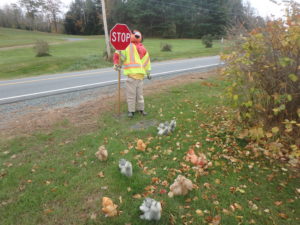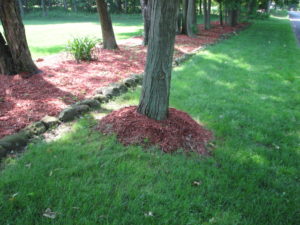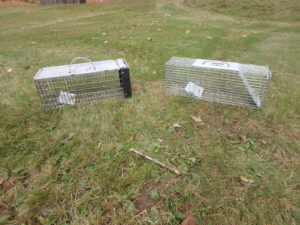What Does a Gardener Do When the Rodents Are Out to Get Us?
Like the Joad family in Steinbeck’s Grapes of Wrath, countless squirrels are on the move. Heedless of traffic, they cross the road in search of new sources of food. Steely-eyed gardeners bear down on them, thinking revenge for the destruction of their crops, particularly tomatoes, apples and pumpkins.
Last year was a “mast” year, meaning that our oaks produced a huge crop of acorns. This fed our squirrels, allowing them to produce more babies. We also had good snow cover last winter, which meant that rodents could hide from owls and hawks.
Voles and mice are not often seen squished on the road, but other signs are evident to me: when I harvested my carrots and potatoes, for example, many had been chewed. And a grand influx of mice into homes has been reported this fall. What can you do to protect your plants and your harvest from all these rodents?
First, if you have fruit trees that are young, you should protect their trunks against rodent damage. Voles, those stocky, short-tailed mouse relatives are the worst culprits. They can reach sexual maturity in just 5 weeks after birth, so they can increase in numbers exponentially, given the right conditions. If hungry enough, they will chew the bark off young fruit trees, killing them by damaging the tender cambium layer all around a tree, girdling it.
To prevent that from happening, you can physically keep the voles away with fine-mesh screening called quarter-inch hardware cloth. It comes in 18- and 24-inch rolls, and I recommend the wider roll. A single layer of mesh screen around the base of the tree will keep the voles a bay. Remove the wire next spring to keep it from getting swallowed up by the bark as the tree grows (that would take a few years, but I’ve seen it happen).
Also available are plastic protectors. Some are tubes slit up the side, others are rolls of plastic to wrap around young trees to protect them from rodents. If your young tree has branches in its lower 2 feet of trunk, you will have to prune off those lower branches to fit the protectors. Mature trees have bark thick enough to deter the rodents.
A few words of warning: do not leave those plastic protectors in place forever. I’ve seen trees damaged by them when left on for a few years – the bark can rot, just as it will if buried in mulch.
As you get ready for winter, check the mulch you may have placed around trees to keep the grass from growing up around them. “Volcanoes” of mulch around trees can be lethal. Mulch holds moisture and often harbors fungal pathogens that will destroy the bark your trees. Instead of a volcano of mulch, create a “donut” of mulch. Leave a few inches of free space around your trees.
While checking the mulch around your trees, also look for the trunk flare. At the ground level you should see trees widen and “flare out”. In mature trees in the forest you will see what appear to be fat roots appear at the foot of the tree, roots that disappear into the soil.
If the flare in a tree you planted is covered with soil, it will damage the bark – and in 6 to 10 years it can kill the tree. You can save your trees from a slow death by pulling back the soil from the base of the tree, exposing the trunk flare.
Moles are commonly blamed for all kinds of atrocities, but they do not eat your plants. They are carnivores that eat grubs and earthworms. If you have a Japanese beetle problem, they will help you by eating the beetle grubs. But in winter or spring moles often cause problems by digging up soil and leaving mounds on the lawn. There are castor oil-based repellents that will discourage them. I do not recommend poisoning them as pets and wildlife can be injured or killed.
Given the high squirrel population you may wonder if you should deport some before winter by trapping them with Hav-a-Heart type humane traps. Probably not, if you care about their well-being. According to what I have read, relocating rodents is not really humane. In a new location they are not likely to survive very long. They will either be eaten by predators or die of starvation.
As to the influx of mice in your house, there really is little you can do besides set traps – either humane ones, or snap traps. But if you store potatoes and carrots in a cool cellar, as I usually do, protect your food from mice and rats. The easiest way to do that is to store them in a second fridge. To keep them from drying out, put them in an open plastic bag with holes punched in it. Potatoes and carrots need to breath in storage. Check them from time to time, and eat them up before they go bad.
We share this planet with our little rodent friends, and I do brake for squirrels. Still, I do all I can to keep them from sharing my harvest or eating my plants.
You may reach Henry at henry.homeyer@comcast.net or by mail at PO Box 364, Cornish Flat, NH 03746. Please include a SASE if you write Henry and want a response by US Mail.





